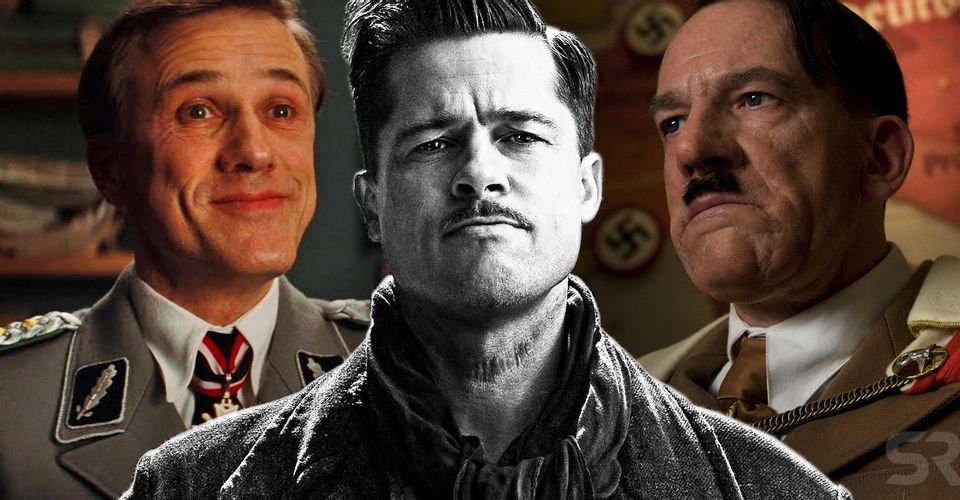Inglourious Basterds True Story: Did ANY Of Quentin Tarantino’s Movie Really Happen?

Quentin Tarantino’s Inglourious Basterds takes place during World War II, but how much of the story is actually true, and did any of it really happen? A fascinating, fictional assassination of Adolf Hitler, the 2009 film is one of Tarantino’s most successful. Produced for $70 million, the 2009 film earned over $321 million at the box office. In addition, Inglourious Basterds received eight Academy Award nominations, with Christoph Waltz taking home an Oscar for Best Supporting Actor. Despite the prestige, Inglourious Basterds’ “true” story isn’t quite as true as the movie would have audiences believe.
Inglourious Basterds stars Brad Pitt as Aldo “The Apache” Raine, the leader of a Nazi-hunting military unit. The titular group is comprised of eight Jewish-American men who have become living legends thanks to their personal accomplishments during World War II. Tarantino’s protege Eli Roth co-stars as Donny “The Bear Jew” Donowitz, an Inglourious Basterd who beats Nazis to death with a baseball bat. The aforementioned Waltz portrays Hans Landa, a Nazi official known as the “Jew Hunter.” French actress Mélanie Laurent plays Shosanna Dreyfus, a Jewish woman who changes her name to Emmanuelle Mimieux after her family is murdered by Landa’s men during the opening chapter.
Tarantino spent 10 years working on the script for Inglourious Basterds, which received great reviews. So is Inglourious Basterds a true story? The answer is complicated. While Tarantino carefully recreates the feeling of wartime movies, it’s far from a true story. Here’s how he blended historical facts with pure fiction, and where Inglourious Basterds deviates from the real history.
The Jew Hunter Is Fake (But The Concept Is Definitely Real)

Hans Landa is a fictional creation of Tarantino, not an Inglourious Basterds true story or real-life historical figure. Instead, he’s a fictional construct used to embody various Nazi concepts. During the opening act, Landa explains the motivations for his actions. He looks for Jewish people because that’s his job, not because he believes himself to be superior — but he wants to be good at his job. The complexity of the character works in favor of the film overall, as Christoph Waltz’s Landa ultimately betrays the Nazi party in order to survive. He’s an egotistical figure, one will do anything to stay one step ahead. As a World War II movie villain, Landa checks off all the appropriate boxes: he’s engaging but dangerous, evil but weirdly charming. By the end, Tarantino doesn’t let him off the hook, though, as Pitt’s Aldo Raine leaves a permanent mark on Landa’s forehead: a swastika.
In real life, the Nazi party itself is “The Jew Hunter.” During World War II, their antisemitic views led directly to the Holocaust, which resulted in the death of approximately six million Jewish people. Since various high-ranking Nazi officials were known for orchestrating the systemic execution of Jewish people, it’s difficult to simply point the finger at one individual person. But for a movie that tweaks a historically true story, a character such as the Inglourious Basterds villain Hans Landa can function as a representation of various ideas and/or people — the late-in-the-day turn and defection was true of many high-ranking Nazis – with side characters reinforcing specific concepts associated with the Nazi party.
There Was a Real Inglourious Basterds Unit (With A Different Origin Story)

The Inglourious Basterds’ titular unit consists of Jewish-American soldiers, with the film’s commercial viability bolstered by Pitt leading the way as an A-list American celebrity. In the story, the Basterds rescue a German man, Hugo Stiglitz (Til Schweiger), who killed 13 Gestapo officers. The Inglourious Basterds in Tarantino’s movie later conspire with English soldier Archie Hicox (Michael Fassbender) and German celebrity Bridget von Hammersmark (Diane Kruger), resulting in one of the film’s most dramatic sequences, set in an underground tavern. Sadly, the Inglourious Basterds scene isn’t a true story.
How Quentin Tarantino’s Shared Universe Connects To Robert Rodriguez’s Movies
In real life, there was indeed a Basterds-like unit that consisted of only Jewish men, but they didn’t take pleasure in murdering other humans, nor did they have aggrandizing nicknames like “The Bear Jew.” The real Inglourious Basterds true story was that they were a secretive British unit known as X-Troop (via Uproxx). Organized by Winston Churchill, the group of Jewish men from Germany and Eastern Europe reportedly focused on collecting information about the Nazis, with their motivations being that they had already experienced the horrors of Nazi antisemitism back home and wanted to protect their families or — in some cases — seek revenge. In the weeks leading up to the infamous D-Day in Normandy, France, X-Troop conducted reconnaissance missions. This real-life Inglourious Basterds team consisted of 88 men, 21 of whom were killed in action, with another 22 suffering wounds.
There Was Also An American Unit That Inspired Inglourious Basterds

In reality, while Inglourious Basterds‘ true story didn’t play out in reality exactly as it did in the movie, it doesn’t mean the real-life historical figures it was based on were any less brave or their stories less exciting. There was plenty of bravery to go around; the British weren’t the only country with their own top-secret and skilled unit of Jewish spies during World War II. X-Troop may have been British, but the Inglourious Basterds of Tarantino’s movie were more international and led by an American.
In real life, the United States had its own counterpart to Britain’s X-Troop. The true story of these real-life Inglourious Basterds is astonishing. It began when two young Jewish refugees living in Brooklyn, Frederick Mayer and Hans Wijnberg, enlisted with the Office of Strategic Services – the precursor to the modern CIA – and volunteered to parachute into Austria deep behind German lines. They later added a third member, Franz Weber, a disillusioned Wehrmacht lieutenant who had had his eyes opened to the reality of Hitler’s genocide and was horrified. Under the codename Operation Greenup, the skilled, three-person team acted as behind-the-line spies to infiltrate the Nazi operation. The makeup of the team and their goals may have been different, but in one way they were the same as the fictional Inglourious Basterds: according to some sources, Weber stated the trio “just wanted to kill Nazis” like Christoph Waltz’s Hans Landa [via National WWII Museum].
The Real-Life Inglourious Basterds’ Mission Was Different

Inglourious Basterds follows the titular group while setting up a plot to assassinate high-ranking Nazis, including Adolf Hitler, at a French movie theater owned by Mimieux. The film ends with the venue being set ablaze, trapping everybody inside. Hitler and his Minister of Propaganda, Joseph Goebbels, are murdered before the theater burns to the ground.
However, the true story of the operation was changed by the movie Inglourious Basterds. Franz Weber may have just wanted to kill Nazis, and he and his team most likely killed a great many, but their real mission was considerably less violent than Tarantino depicts. Instead of a plot to infiltrate the German operation to kill Nazis, the mission of the real-life Inglourious Basterds was intelligence and information gathering. That’s not to say there wasn’t danger and violence involved — at one point in their mission, Mayer was captured by the Gestapo and nearly tortured to death — but the main goal was to infiltrate, not kill. Mayer and Wijnberg confounded German intelligence by layering a map of Brooklyn over the city of Tyrol, Austria, where they were initially stationed, using Brooklyn landmarks that corresponded with ones in Tyrol and creating an entirely new set of code names for locations that stymied Nazi intelligence officer.
While Inglourious Basterds ended with Hitler and his top men being burned to death, in real-life, the dictator suffered a different fate. Nonetheless, the Allied team was victorious, just the same. Through Operation Greenup, they filtered tons of classified information from the Nazis to the U.S. and its allies, smuggling invaluable data back to their contacts. In the end, Weber, Mayer, and Wijnberg’s work behind enemy lines likely saved thousands of American and Austrian citizens and soldiers. Meanwhile, their European counterparts X-Troop and others were equally successful, filtering classified information and conducting a number of significant raids on German supplies throughout the war.
Many People Tried To Assassinate Hitler (But Not In A French Movie Theater)

Hitler’s death is well documented. By April 1945, the Soviet Red Army had taken control of Berlin, the Nazi capital. Rather than facing the consequences, Hitler reportedly killed himself alongside his wife Eva Braun, just one day after their marriage ceremony. Their bodies were completely burned to ashes, though the Führer’s jaw was allegedly identified.
In the movie, however, it plays out in a far more dramatic fashion. An Inglourious Basterds scene changes the dictator’s death, ending with Hitler being killed at Emmanuelle Mimieux’s movie theater. The Americans win. Landa turns on the Nazis. Shosanna becomes a martyr. While none of that happened, for obvious reasons, many people really did attempt to assassinate Hitler during World War II. In fact, historians have documented at least 42 plots.
In 1932, an unknown would-be assassin tried to poison Hitler at the Hotel Kaiserhof in Berlin. By the summer of 1934, the Führer set in motion the “Night of the Long Knives,” in which he orchestrated the executions of numerous political figures in order to eliminate his opponents. It was a power move, with the Schutzstaffel (SS) serving as Hitler’s henchmen. In response, a German military volunteer named Beppo Römer planned to kill Hitler but was swiftly arrested. Years later, he conspired again with the group Solf Circle, but the plan was discovered by the Gestapo. Römer was sent to a concentration camp at Dachau and later executed in 1944. In November 1939, a carpenter named Georg Elser planted a bomb at a Munich beer hall, hoping to kill Adolf Hitler in a plot closest to Inglourious Basterds‘ story. The plan failed horribly, as eight innocent people died and 62 others were injured.
Moviegoers may be familiar with a July 1944 Hitler assassination attempt that’s depicted in Bryan Singer’s 2008 film Valkyrie. Tom Cruise portrays Colonel Claus von Stauffenberg, who previously lost his eye during an Allied attack in Tunisia. Operation Valkyrie was an emergency plan that would result in the Territorial Reserve Army of Germany taking control if and when Hitler was killed. But the assassination attempt ultimately failed, and von Stauffenberg was executed the next day in Berlin at age 36. Hitler killed himself nine months later. In the end, Inglourious Basterds is an entertaining and partially true story, but it’s fictionalized in order to fit Tarantino’s specific brand of filmmaking.
About The Author


















